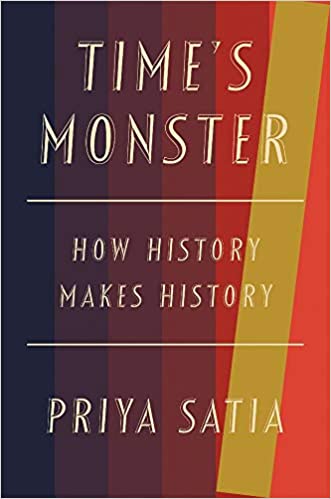
 In the global resurgence of the far-right and white supremacist ideology over the past two decades, the debate over the past, history, and History as an academic discipline, looms large. Attempting to, among other things, control the national narrative of the past, Hungary’s Fidesz evicted the Central European University, Poland’s Law and Order party has placed effective muzzles on the work of Holocaust historians, and the UK’s Conservative government has recently attempted to establish a tighter control over discourse in British universities due to a perceived “free speech” crisis—not to mention Donald Trump’s short-lived “1776 Commission,” which sought to promote “patriotic” history education in the United States. The response from liberal commentators tends to stress the empirical falsity of these claims, as well as their disingenuous arguments—CEU’s closure was due to antisemitic conspiracy theories centered around George Soros, the Polish ruling is part of a decades-long attempt to whitewash Polish participation in the Holocaust, and there is no empirically demonstrable threat to free speech from “cancel culture” (except perhaps against the left). These counter-claims do carry the weight of evidence and should indeed be championed as necessary ripostes to oppressive regimes. There is, however, a claim that is frequently associated with these that has assumed a larger space in the discourse: If people only knew proper or correct history (history according to professional historians, History), they would not fall prey to the claims of authoritarian reaction. Therefore, redress must focus on amplifying those voices, as the discipline of History is a force for good.
In the global resurgence of the far-right and white supremacist ideology over the past two decades, the debate over the past, history, and History as an academic discipline, looms large. Attempting to, among other things, control the national narrative of the past, Hungary’s Fidesz evicted the Central European University, Poland’s Law and Order party has placed effective muzzles on the work of Holocaust historians, and the UK’s Conservative government has recently attempted to establish a tighter control over discourse in British universities due to a perceived “free speech” crisis—not to mention Donald Trump’s short-lived “1776 Commission,” which sought to promote “patriotic” history education in the United States. The response from liberal commentators tends to stress the empirical falsity of these claims, as well as their disingenuous arguments—CEU’s closure was due to antisemitic conspiracy theories centered around George Soros, the Polish ruling is part of a decades-long attempt to whitewash Polish participation in the Holocaust, and there is no empirically demonstrable threat to free speech from “cancel culture” (except perhaps against the left). These counter-claims do carry the weight of evidence and should indeed be championed as necessary ripostes to oppressive regimes. There is, however, a claim that is frequently associated with these that has assumed a larger space in the discourse: If people only knew proper or correct history (history according to professional historians, History), they would not fall prey to the claims of authoritarian reaction. Therefore, redress must focus on amplifying those voices, as the discipline of History is a force for good.
In a stimulating look at these types of claims, historian Priya Satia’s Time’s Monster: How History Makes History suggests that what is missing is in fact a critical look at the discipline of History itself, and that such an examination, far from securing History as the ready-made answer to fascism and racism, reveals an internal structure that was, until quite recently, predicated entirely on maintaining oppression across the globe. At its heart, Time’s Monster is about the ethical foundation of the British Empire, specifically the story “of inhumanity perpetrated by individuals deeply concerned with their consciences,” with the central question: “How did such avowedly ‘good’ people live with doing bad things?” (5). In Satia’s persuasive reckoning, the answer is (largely) through the critical power of History. While this is not an attack on History as such, it is a useful look at how the professional practice of history was at the center of British imperial power. History, and the attendant progress narratives that suggested it was a power in itself, served as a means of regulating conscience—tamping down ethical queasiness at slavery and colonial domination, and helping to secure the idea that individual actions were—for better or worse—constrained through transcendental movement forward. “Historical thinking,” Satia writes, “is like the god whispering in Santal’s ear; it is the ghost in Hamlet, at once goading and absolving morally dubious action” (54). The key here is that, in the modern world, history is not an incontrovertible series of objective facts ready for moral interpretation, but a series of narratives always already mediated by History and its practitioners.
This conclusion will not be surprising or novel for most professional historians. More than a half-century of poststructuralist philosophy and literary criticism, social history, queer theory, and postcolonial theory have all worked to dismantle the “progress” idea in History. At least within the US academy, historians of empire generally hold to this critical understanding, and conservative opponents are given little credence. This new disciplinary convention, however, does not seem to reach the popular understanding of history. Politicians frequently deride the work of professional historians as being without merit, primary and secondary history education is still dominated by a largely patriotic (if more multicultural) curriculum, and popular history as a genre is dominated by overly technical celebrations of Western militaries or hagiographies of (most while and male) singular historical figures. This has largely sidelined History from the realm of “expertise” called upon by the state to craft policy—a stunning reversal from more than a century of taking pride of place in supporting imperial conquest. In short, History’s past has become a specter haunting its present, with a progressive, pro-imperial narrative so ingrained in the popular and political conscience that it actively impedes the work of its descendant.
Time’s Monster charts this development, beginning with a reading of Romantic ideology as foundational to the notion of progress-oriented history. Satia argues that figures like Lord Byron, searching abroad for noble causes to further their own moral worth, created a “script for future adventurers abroad” (68), establishing a narrative whereby the more enlightened Britons were justified by morality and history itself to go out into the world bringing liberation by whatever means necessary. From this point, Satia charts a path through intellectual and imperial history, showing how a new future-oriented history came to be seen by British thinkers (and imperial boosters) like John Stuart Mill and Thomas Carlyle as being absolutely essential to the imperial project. Discussing the often-joined colonial crises of the 1857 Indian Rebellion and 1865 Morant Bay Rebellion in Jamaica from several angles, Satia argues that History, and its attachment to transcendental narratives, played an integral part in the support of empire during these and other troubled times. Indeed, it was the work of historians that would allow for the framing of these moments of indisputable moral panic as being predicated on “a bad imperialist[…]not empire itself” (117). In a fascinating juxtaposition, Satia contrasts the work of Indian historian and supporter of the rebellion Maulvi Mohammed Baqar with that of Mill and other British colonial figures to demonstrate the ways in which the pervasive colonial influence of History made this conflict an explicit History War (87).
Perhaps the most useful point of Time’s Monster is as a call for dealing with History’s imperial past so as to regain a more direct and useful engagement with the moral problems of the present. The tainted past of academia is not a new story. “Race science,” using modern scientific methods, was the direct support of atrocities from the Atlantic slave trade to the Holocaust—although this reckoning has been complicated by both an insistence from within STEM fields that science is inherently an-ideological and the more recent claim by liberals that progressive politics involves a “belief” in science. Anthropology (closer to home) was wracked by an internal crisis from the 1970s on in which scholars grappled with the reality that their methods, early texts, and foundational assumptions had all come into being explicitly to serve empire. History has never had such a reckoning. Perhaps related to both a false sense of ancientness and a belief in the objectivity of the discipline, History largely either holds itself aloof from the moral problems of its past, or assumes, like uncritical scientists, that the accumulation of better data will fix “mistakes” of missing information and bad analysis from past history writing. The second method leads to the “balance-sheet” approach, especially in terms of imperial history, where historians are to engage in a debate over the supposed pros and cons of empire (the British are directly responsible for millions of famine deaths in India, but did also build railroads, in one of the more common face-offs).
As Satia argues, the frame of this debate gives away the game. By assuming that it’s possible to arrive at an ethical decision through this balancing of good and bad, even anti-colonial historians are implicitly endorsing exactly the kind of History that was marshaled to support empire: the idea that individual acts are always mediated and mitigated by a longer moral arc. In one telling example, she notes how EP Thompson, no supporter of empire, was morally disappointed in post-independence India, as though independence or domination are conditions to be weighed in service to a transcendental goal (265). In contrast, Satia calls for historians to directly participate not in these kinds of histories that both implicitly support the logic of empire and imagine that it is a closed matter, but in forms of history-making that are self-consciously critical. In many ways, Satia’s conclusions echo those of crisis-bound anthropologists and postcolonial precursors. Brilliant analysis and searing critique are followed with the conclusion that despite all the problems and, with what amount to only minor adjustments in method, academic History can now be seen as a worthwhile part of the solution, even if its newly critical present is nowhere near as influential as its colonial past. Again, like the anthropologists of the 1970s and ‘80s, Satia somewhat awkwardly ducks the obvious conclusion of the preceding two hundred pages—perhaps we are ethically bound to at least touch the third rail in the room that, given past and present abuses and seemingly-intractable limitations, the academy needs to either undergo a revolution or be disbanded. A useful injunction against banal diversity/“inclusion” and gestures toward memorialization and other public history aside, the conclusion that a critically oriented but otherwise intact professional Discipline is disappointing but neither surprising nor fatal for the overall argument.
Overall, Time’s Monster is a necessary book for scholars of empire and for historians more generally (especially historians of Europe and settler states). By charting the ways in which history and History grew up with colonialism, noting the close relationship between the academic discipline and power, the stickiness of transcendental philosophies, and the ways in which the sins of the colonial past cannot be washed off by the simple passing of time, Satia demands that all historians and ultimately all humanists attend to the complicities of our work and our disciplines and at the very least acknowledge the problems of our academic lineages. Beyond this, and perhaps more urgently, the work is a sublime answer to the legions of people, professional scholars and otherwise, who loudly claim that “knowing history” is sufficient to organically resist oppressive politics of all stripes.
Andrew Schumacher Bethke is a PhD candidate in History at the University of Minnesota. His work considers the role of Oxford University in the administration of British India.
Time’s Monster: How History Makes History
By Priya Satia
Publisher: Harvard University Press
Hardcover / 384 pages / 2020
ISBN 9780674248373
Published on May 11, 2021.




